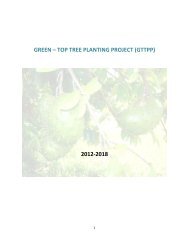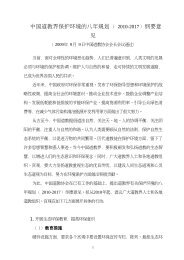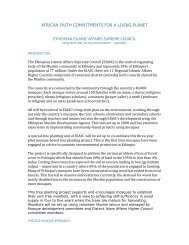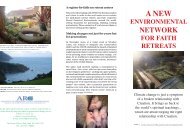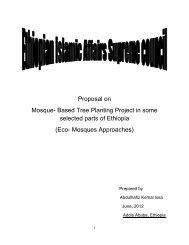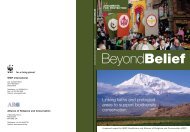summary paper - Alliance of Religions and Conservation
summary paper - Alliance of Religions and Conservation
summary paper - Alliance of Religions and Conservation
You also want an ePaper? Increase the reach of your titles
YUMPU automatically turns print PDFs into web optimized ePapers that Google loves.
future.<br />
The first ecology workshop was held this July. We had invited 14 Daoist monks <strong>and</strong> nuns from ten<br />
temples in Shaanxi <strong>and</strong> Gansu provinces. At the end we all signed a commitment known as the Qinling<br />
Declaration to protect the environment around our sacred l<strong>and</strong>s <strong>and</strong> buildings. We hope this will be a<br />
model for future declarations to preserve some <strong>of</strong> our country's most sacred l<strong>and</strong>scapes。<br />
We have also formed a "Daoist Temple <strong>Alliance</strong> on Ecology Education" <strong>and</strong> have agreed to send<br />
representatives regularly to workshops <strong>and</strong> to share our experiences in protecting our country's sacred<br />
Daoist l<strong>and</strong>scapes.<br />
Daoism judges a person's affluence by the number <strong>of</strong> different species in his or her environment. If all<br />
things grow well, then a society is affluent. If they don't grow well, then the kingdom is on decline. This<br />
view should encourage both governments <strong>and</strong> people to take good care <strong>of</strong> nature. Because we all want a<br />
truly affluent society in which to live.<br />
Thank you.<br />
Ronan Murphy<br />
Director General, Development Cooperation Directorate, Department <strong>of</strong> Foreign Affairs, Irel<strong>and</strong><br />
Summary <strong>of</strong> Paper<br />
The presentation described a development practitioner’s perspective on the relationship between the<br />
environment <strong>and</strong> development. While the basic texts for development practitioners are secular, there are<br />
links <strong>of</strong> various kinds with religion. The dimensions where the environment <strong>and</strong> development intersect<br />
are examined under three headings: livelihoods, health <strong>and</strong> vulnerability. Development interventions<br />
include specific environmental projects, support for multilateral environmental organisations <strong>and</strong><br />
mainstreaming environmental concerns in the overall aid programme. Examples <strong>of</strong> interventions are<br />
described. Partnership is the key to development. The role <strong>of</strong> religious leaders in supporting sustainable<br />
development was discussed.<br />
Bron Taylor<br />
Samuel S. Hill Pr<strong>of</strong>essor <strong>of</strong> Religion, The University <strong>of</strong> Florida:<br />
www.religion<strong>and</strong>nature.com<br />
‘ ‘World Religion,’ ‘Nature Religion,’ <strong>and</strong> the Quest for Sustainability’<br />
What follows is an outline/overview <strong>of</strong> what was planned to be presented <strong>and</strong> embellished at the<br />
conference.<br />
While I have been have spent considerable time documenting the rise <strong>of</strong> environmentalism among the<br />
world’s most prevalent faith traditions, including in The Encyclopedia <strong>of</strong> Religion <strong>and</strong> Nature, which I<br />
edited <strong>and</strong> published recently, in this presentation my focus today will be different. I will argue:<br />
1) The notion <strong>of</strong> “world religions” is increasingly recognized by scholars as problematic.<br />
This ought to give us pause when we use conventional underst<strong>and</strong>ings <strong>of</strong> what count as<br />
“world religions” as an organizing principle for considering human religious <strong>and</strong> spiritual<br />
relationships to nature.<br />
2) Choices that privilege “world religions” over forms <strong>of</strong> religions <strong>and</strong> spiritualities that are<br />
not generally understood in this way, exclude a great deal <strong>of</strong> human religious perception<br />
<strong>and</strong> practice that is directly relevant to the quest for sustainability <strong>and</strong> the possibility that<br />
“religion” might inspire positive environmental action. This is the case whether these<br />
choices are made by conference organizers or scholars.<br />
27



